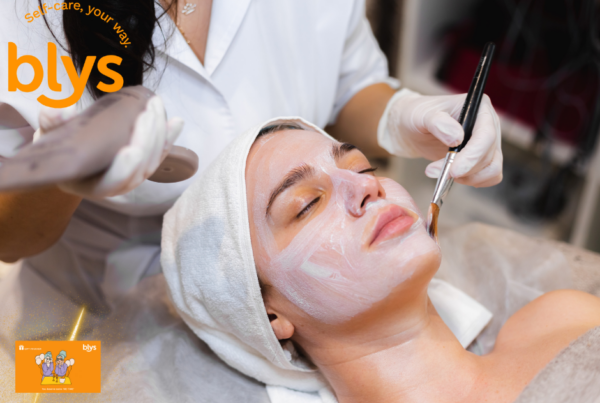
Your hair type is more than just a category on a beauty chart; it’s the foundation for how your hair looks, feels, and responds to styling. The thickness of each strand, the way it holds moisture, and the natural curl pattern all influence how products work, how long styles last, and how healthy your hair stays over time. Without understanding your hair type, you might end up using the wrong products, over-styling, or missing out on techniques that could actually make your hair easier to manage.
When you know your hair type, you can choose the right shampoos, conditioners, and treatments, set realistic expectations for styles, and take steps to protect your hair from damage. It also makes working with a professional stylist much more effective; they can tailor every step of your cut, color, or blow-dry to suit your hair’s unique needs.
That’s where at home hair services come in. Instead of trying to figure it all out on your own, a mobile stylist can visit you, assess your hair type in person, and recommend the perfect routine and style without you having to leave the house. It’s salon-quality expertise, brought right to your door for maximum convenience.
The Four Main Hair Types
Hair types are generally grouped into four main categories, each with distinct traits that influence how your hair looks, feels, and behaves. While these categories are a great starting point, it’s worth noting that most people don’t have a single “pure” type.
You might notice that your crown is wavier than your fringe or that your ends have a looser curl than the roots. Recognizing these variations helps you adapt your care routine to suit your hair’s unique needs.
Straight Hair
Straight hair has a naturally smooth cuticle layer, allowing light to reflect easily for a glossy finish. Its flat structure means natural oils from the scalp can travel down the hair shaft more quickly, which keeps it conditioned but can also make it appear oily sooner.
It’s great for sleek, polished styles and tends to resist tangling, but it may struggle to hold curls or waves without heat styling or product support. Layered cuts, dry shampoo, and lightweight volumizing sprays are often useful for adding movement and lift.
Wavy Hair
Wavy hair sits between straight and curly, forming gentle S-shaped patterns that can range from loose, beachy bends to more defined waves. It offers styling versatility; you can smooth it out for a sleek look or enhance the waves for natural texture. However, its cuticle structure makes it more prone to frizz, particularly in humid climates.
To bring out the best in wavy hair, use lightweight, curl-enhancing products and avoid heavy creams or oils that can weigh it down. A professional hair stylist home visit can help shape your waves so they fall more evenly and frame your face beautifully.
Curly Hair
Curly hair is characterized by springy loops, spirals, or ringlets. The shape of the strand makes it more challenging for natural oils to travel from root to tip, which is why curly hair often feels drier. This hair type naturally has more volume and body but requires regular hydration and gentle detangling to maintain definition.
Using sulfate-free cleansers, rich conditioners, and techniques like “plopping” or diffusing can help preserve curl shape. Many curl types also benefit from trims every 8-12 weeks to maintain shape and prevent split ends.
Coily/Kinky Hair
Coily hair features very tight curls or zig-zag patterns that can shrink considerably from their actual length. It is the most delicate hair type due to its sharp bends, which create more points where breakage can occur. Because of its structure, coily hair tends to be dry and thrives on deep moisture, protective styles, and minimal heat use.
Hydrating leave-ins, natural oils, and low-manipulation styling are key to keeping it healthy. A mobile stylist experienced in coily hair care can provide protective styles and tailored treatments without you having to visit a salon.
Understanding these categories and the fact that your hair may be a blend makes it easier to find the right products, adopt suitable techniques, and know when to bring in professional help. With at home hair services, you can have a stylist assess your exact type, suggest a routine that works, and style your hair in a way that enhances its natural beauty, all without leaving the comfort of your home.
If you’re ready to book, our tips on how to choose the right mobile hair stylist can help you find a professional who matches your style, needs, and schedule.
How to Identify Your Hair Type
Before you can choose the right products, tools, or styles, you need to know exactly what you’re working with. Understanding your hair type is the first step to building a routine that keeps it healthy, manageable, and looking its best. It’s not just about whether it’s straight, wavy, curly, or coily; the finer details make all the difference.
- Curl pattern: The natural shape your hair forms when air-dried, from straight strands to tight coils.
- Strand thickness: Fine, medium, or coarse strands; check by rolling one between your fingers.
- Porosity: How well your hair absorbs and holds moisture; slide your fingers up a strand to feel for bumps.
- Density: How many strands you have; part your hair to see how much scalp shows.
- Elasticity: How far your hair stretches before breaking, which reflects its strength and moisture balance.
These simple checks can be done at home, but they only give part of the picture. A trained eye can pick up on subtle differences and recommend products, techniques, and styles that suit you perfectly. Booking an at home hair stylist gives you a personalized assessment and expert advice without the hassle of travelling to a salon, making it easier to get the results you want, right in the comfort of your own space.
Hair Care Routines for Each Type
Once you’ve identified your hair texture, the next step is choosing a care routine that enhances your hair rather than working against it. Each hair category handles styling and moisture differently; what flatters one person’s hair might leave another’s limp, frizzy, or damaged.
The key is routine consistency, which helps maintain health, manageability, and style longevity, whether you’re styling it yourself or booking a hair stylist at home for expert guidance.
Straight Hair Care
Straight hair often looks glossy because its cuticle lies flat, allowing light to reflect easily. It also means natural oils travel swiftly from the scalp to the ends, providing shine but sometimes too much, leading to greasiness. Start with lightweight shampoos and conditioners that cleanse without residue, and avoid heavy oils or rich creams that can weigh straight strands down.
Heat protectants are essential when styling, as damage shows easily on sleek hair. The American Academy of Dermatology suggests trimming every 6–8 weeks for healthy ends and better maintenance.
Wavy Hair Care
Wavy hair sits between straight and curly, offering natural texture with a vulnerability to frizz in humid climates. For defined, weightless waves, use light curl creams or gels, and apply anti-frizz serum, especially on damp hair.
A diffuser helps maintain texture, while scrunching with a microfiber towel or T-shirt keeps frizz at bay. Vogue notes that waves “crave moisture” and recommends sulfate-free moisturizing shampoos, weekly hair masks, and lightweight products to maintain shape without flattening.
Curly Hair Care
Curly strands often feel drier because their shape makes it difficult for scalp oils to travel down the hair shaft. Opt for sulfate-free cleansers to preserve hydration, and use rich conditioners or weekly deep treatments to keep curls soft and defined.
Techniques like finger-coiling or gently raking product through damp hair can enhance curl shape, and air-drying or low-heat diffusing reduces frizz. The Beauty Book Nykaa advises avoiding brushing dry curls, which disrupts the pattern and causes breakage.
Coily Hair Care
Coily hair features tight curls or zig-zag patterns and is especially fragile and prone to dryness. Hydration is best achieved using a structured routine: begin with a leave-in conditioner, layer with a hydrating cream, then seal with oil, known as the LOC (liquid, oil, cream) or LCO method, to maximize moisture retention.
Protective styles like braids or twists minimize handling, and detangling should be done gently with fingers or a wide-tooth comb while hair is conditioned and damp. The LOC method article highlights that this layered technique boosts hydration and curl definition.
No matter your hair type, consistency is key. A routine aligned with your texture supports hair health, enhances styling results, and reduces the risk of damage. For a truly personalized approach, booking an at home hair stylist ensures your cut, treatments, and techniques are tailored to your unique texture, all from the comfort of your home.
Styling Tips by Hair Type
Great styling isn’t about forcing your hair into a shape it resists; it’s about working with your natural texture to create looks that are flattering, manageable, and long-lasting. Understanding which styles suit your hair type can save time, reduce damage, and help you get more wear out of your favorite looks.
With the right approach, you can make the most of what you have, whether you’re preparing for a quick coffee run or a big night out.
| Hair Type | Go-To Styles | Key Styling Tips |
| Straight Hair | Sleek ponytail, layered cuts, textured waves | Use a heat protectant before curling; add dry shampoo for volume; finish with a shine spray for a polished look. |
| Wavy Hair | Beach waves, half-up braids, layered bob | Apply lightweight mousse or curl cream to damp hair; diffuse to define texture; avoid heavy serums that weigh down waves. |
| Curly Hair | Pineapple updo, wash-and-go, voluminous fro | Apply leave-in conditioner and curl cream; use the “plopping” method to set curls; avoid brushing when dry to maintain definition. |
| Coily Hair | Twist-outs, braided buns, tapered cuts | Moisturize before styling; use edge control for sleekness; incorporate protective styles to minimize breakage. |
Straight hair works well with sleek, minimalist looks. A sleek ponytail is both chic and easy, layered cuts add movement, and a curling wand can create soft waves for extra texture.
Wavy hair offers natural body that’s simple to enhance. Beach waves suit a relaxed style, half-up braids add visual interest, and a layered bob helps control bulk while keeping bounce.
Curly hair looks best when its shape is defined. A pineapple updo protects curls while looking stylish, a wash-and-go routine keeps the natural pattern intact, and a voluminous fro makes a confident statement.
Coily hair is versatile and expressive. Twist-outs enhance curl definition, braided buns offer a polished protective option, and tapered cuts frame the face beautifully while reducing styling time.
While you can achieve many of these looks at home, a professional hair stylist home can create styles that not only last longer but also complement your features and protect your hair’s health. With expert tools, products, and techniques, your style can hold for days instead of hours, giving you a polished finish with less effort.
You can also check out our guide on the benefits of at-home hair services to see why more people are swapping salon trips for expert care in the comfort of their own home.
Common Hair Care Mistakes to Avoid
Even the most well-meaning routines can work against your hair if they’re not tailored to your needs. Small habits, repeated over time, can lead to dryness, frizz, breakage, or styles that simply don’t hold. Recognizing the most common mistakes is the first step to breaking them and building healthier habits that help your hair look and feel its best.
- Over-washing: Washing too often strips away your hair’s natural oils, leaving it dry and prone to frizz. In some cases, it can even make the scalp produce more oil to compensate, leading to an oily root–dry ends combination.
- Using the wrong products: If a shampoo, conditioner, or styling product isn’t suited to your hair type or porosity, it can cause buildup, weigh hair down, or fail to provide needed moisture and protection.
- Skipping trims: Going too long between haircuts allows split ends to travel up the strand, which can make hair look rough, frizzy, and more difficult to style.
- Excessive heat use: Over-reliance on straighteners, curling irons, or blow dryers without heat protection weakens the cuticle and causes lasting damage over time.
The easiest way to avoid these pitfalls is by tailoring your care routine and keeping it consistent. Regular at home hair services make it simple to stay on top of trims, get personalized product recommendations, and enjoy professional styling techniques that protect your hair, all without stepping outside your home.
Choosing the Right Products for Your Hair Type
The products you use can make or break your hair care routine. Even the best styling techniques won’t deliver results if your shampoo, conditioner, or treatments don’t match your hair’s unique needs. Selecting the right products starts with understanding what’s in them and how they work for your texture, porosity, and overall condition.
Read ingredient labels carefully
Ingredients are listed in order of concentration, so the first few items make the biggest impact. If your hair is dry, look for humectants like glycerin or aloe, nourishing oils like argan or jojoba, and proteins such as keratin. If your hair gets oily quickly, focus on lightweight formulas without heavy silicones or waxes that can build up on the scalp.
Match products to your porosity and texture
Low-porosity hair benefits from lighter products that can penetrate the cuticle, while high-porosity hair needs richer creams and oils to lock in moisture. Fine hair may need volumizing and strengthening formulas, whereas coarse hair responds well to smoothing and hydrating blends.
Get expert input when unsure
A professional hair stylist home session is one of the easiest ways to get personalized recommendations. During the appointment, your stylist can assess your hair’s type, porosity, and condition, then suggest products that will give you the best results, saving you the trial-and-error (and wasted money) of guessing on your own.
When to Book a Professional Hair Stylist at Home
While everyday styling can often be managed at home, there are moments when professional expertise can make all the difference. Knowing when to call in a stylist can help you get the best results without the stress, wasted time, or damage that can come from trying to do it all yourself.
Special events such as weddings, formal gatherings, or photo shoots are perfect occasions for professional styling, ensuring your look is polished and long-lasting. Major style changes, whether it’s a big chop, adding layers, or trying a completely new color, are also best left to a trained eye to ensure the result flatters your face shape and hair type.
If your hair is damaged from heat, chemical treatments, or environmental stress, a stylist can recommend restorative treatments and trim strategically to promote healthy regrowth. Even seasonal transitions, like moving from humid summer air to dry winter heat, can benefit from an expert refresh and tailored product advice.
Mobile hair services make the process even easier. With no travel, flexible scheduling, and the comfort of being styled in your own space, you can enjoy salon-quality results without disrupting your day.
For tips on keeping your hair healthy year-round, read our at-home hair care guide between appointments for easy maintenance steps you can do yourself.
Healthy, Stylish Hair Made Simple With Blys
Understanding your hair type is more than just a beauty tip; it’s the foundation for every decision you make about your hair. From the products you choose to the way you style and protect it, knowing your texture, porosity, and unique characteristics allows you to work with your hair’s natural strengths instead of fighting against them.
It’s the difference between a style that lasts a few hours and one that holds beautifully all day, or between hair that struggles with breakage and hair that stays strong and healthy. While at-home care plays a big role in keeping your hair in top condition, there’s real value in pairing it with professional expertise.
A skilled stylist can spot subtle issues you might overlook, recommend treatments that address your specific concerns, and use techniques that maximize your hair’s potential. Regular trims, personalized treatments, and expert styling all contribute to keeping your hair looking and feeling its best year-round.
With Blys Hair Services, you don’t have to choose between convenience and quality. You can enjoy salon-grade results without the commute, waiting time, or disruption to your schedule, all from the comfort of your own space.
Explore our full range of at-home hair services to find the perfect cut, color, or style without leaving your home.





